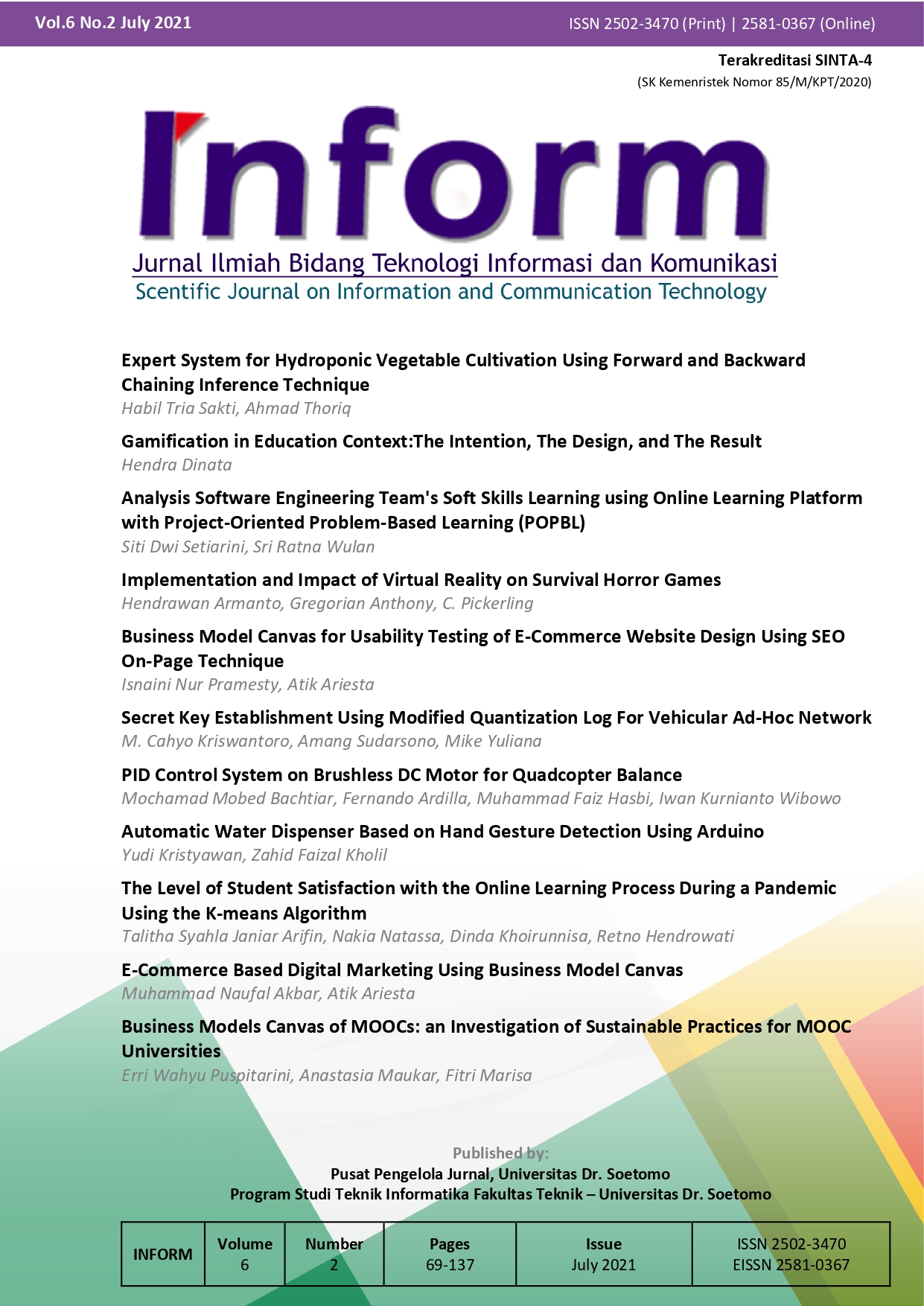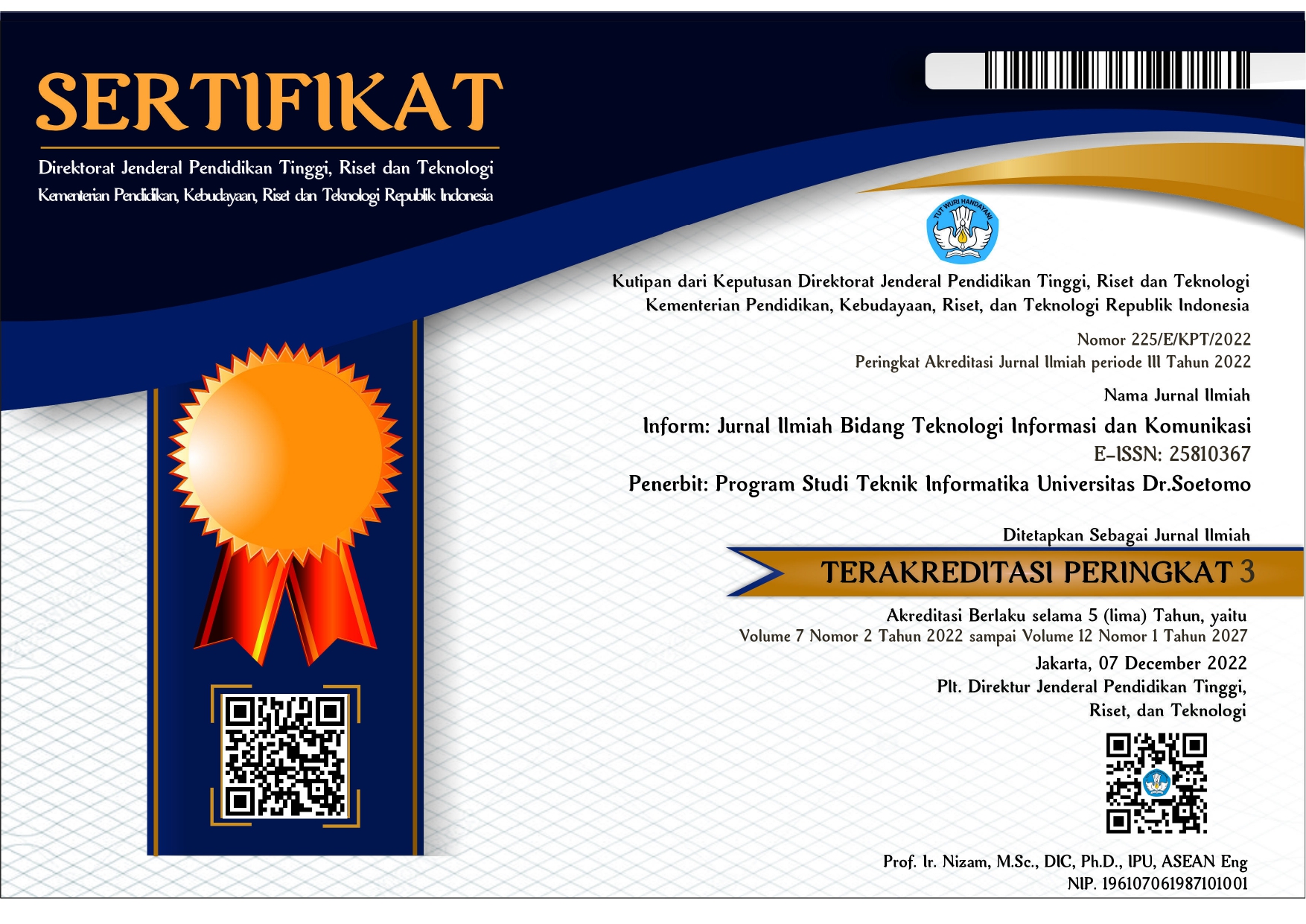The Level of Student Satisfaction with the Online Learning Process During a Pandemic Using the K-means Algorithm
 Abstract views: 423
,
Abstract views: 423
,
 PDF downloads: 385
PDF downloads: 385
Abstract
The number of cases of Covid-19 in this pandemic era is increasing and getting out of control every day. This triggers the Indonesian government to set policies on schools with online learning methods. Of course, online learning cannot ensure that it runs smoothly in all circles because several factors hinder the learning process. The difficulty of the internet network, limited quotas, unfamiliarity with the use of learning media, and an unsupportive environment for conducting online learning are the obstacles to ineffective online learning. The purpose of this study was to determine the level of satisfaction with online learning during the pandemic. This study uses quantitative research methods with a descriptive approach. Quantitative research methods will be processed into data mining using the K-Means Clustering Algorithm. The clustering process is carried out to get the results of clustering the level of student satisfaction. The dataset was obtained from the results of the questionnaire by submitting statements of satisfaction and dissatisfaction. The cluster type is based on high, medium, and low class. The test results obtained a value with the final iteration, namely the level of satisfied statements is categorized as high with a value of 11.79 compared to the dissatisfied statement, which is categorized as moderate with a value of 7.46. In contrast, for the low category level, there is no value of 0.00 cluster results state that the category is satisfied with online learning with a value of 9.33.
References
A. Susilo et al., “Coronavirus Disease 2019: Tinjauan Literatur Terkini,” J. Penyakit Dalam Indones., vol. 7, no. 1, p. 45, 2020.
R. N. Putri, “Indonesia dalam Menghadapi Pandemi Covid-19,” J. Ilm. Univ. Batanghari Jambi, vol. 20, no. 2, p. 705, 2020.
A. Harapani, “Pengaruh Kuliah Daring Saat Pandemi Covid-19 Terhadap Kemampuan Mahasiswa,” 2020.
R. D. Buana, “Analisis Perilaku Masyarakat Indonesia dalam Menghadapi Pandemi Covid-19 dan Kiat Menjaga Kesejahteraan Jiwa,” Sos. dan Budaya, Fak. Syariah dan Huk. Univ. Islam Negeri Syarif Hidayatullah Jakarta, vol. 53, no. 9, pp. 1689–1699, 2017.
Y. Fitriyani, I. Fauzi, and M. Z. Sari, “Motivasi Belajar Mahasiswa Pada Pembelajaran Daring Selama Pandemik Covid-19,” Profesi Pendidik. Dasar, vol. 7, no. 1, pp. 121–132, 2020.
A. Hutauruk and R. Sidabutar, “Kendala pembelajaran daring selama masa pandemi di kalangan mahasiswa pendidikan matematika: Kajian kualiatatif deskriptif,” J. Math. Educ. Appl., vol. 02, no. 01, pp. 45–51, 2020.
D. A. Kusuma, “Dampak Penerapan Pembelajaran Daring Terhadap Kemandirian Belajar (Self-Regulated Learning) Mahasiswa Pada MataKuliah Geometri Selama Pembelajaran Jarak Jauh Di Masa Pandemi Covid-19,” Teorema Teor. dan Ris. Mat., vol. 5, no. 2, p. 169, 2020.
A. Sadikin and A. Hamidah, “Pembelajaran Daring di Tengah Wabah Covid-19,” Biodik, vol. 6, no. 2, pp. 109–119, 2020.
M. Barseli and I. Ifdil, “Konsep Stres Akademik Siswa,” J. Konseling dan Pendidik., vol. 5, no. 3, p. 143, 2017.
R. Novita, “Teknik Data Mining : Algoritma C4.5,” Ilmu Komputer.com, pp. 1–12, 2016.
L. Yang and A. Shami, “On hyperparameter optimization of machine learning algorithms: Theory and practice,” Neurocomputing, vol. 415, no. November, pp. 295–316, 2020.
A. F. Wardatul Maghfiroh, Nurissaidah Ulinnuha, “Penerapan Fuzzy C-Means dalam Mengelompokkan Kabupaten/Kota Berdasarkan Fasilitas Pelayanan Kesehatan Di Jawa Timur,” Inf. J. Ilm. Bid. Teknol. Inf. dan Komun., vol. 4, no. 1, pp. 8–14, 2019.
W. Maghfiroh and N. Ulinnuha, “Application of Fuzzy C-Means in Grouping Districts/Cities Based on Health Service Facilities in East Java,” Inf. J. Ilm. Bid. Teknol. Inf. dan Komun., vol. 3, no. 2, pp. 62–68, 2018.
M. Kurniawan, R. R. Muhima, and S. Agustini, “Comparison of Clustering K-Means, Fuzzy C-Means, and Linkage for Nasa Active Fire Dataset,” Int. J. Artif. Intell. Robot., vol. 2, no. 2, p. 34, 2020.
M. Khozin, D. Cahyono, and T. A. Wijaya, “Sistem Pendukung Keputusan Penerimaan dan Pengelompokan Kelas Peserta Didik Baru di SMP Islam Parlaungan Waru Sidoarjo,” Inf. J. Ilm. Bid. Teknol. Inf. dan Komun., vol. 1, no. 2, pp. 98–107, 2016.
S. Fikri and N. Ulinnuha, “Perbandingan Metode Single Linkage , Complete Linkage Dan Average Linkage dalam Pengelompokan Kecamatan Berdasarkan Variabel Jenis Ternak Kabupaten Sidoarjo,” Inf. J. Ilm. Bid. Teknol. Inf. dan Komun., vol. 4, no. 2, 2019.
R. R. Muhima, M. Kurniawan, and O. T. Pambudi, “A LOF K-Means Clustering on Hotspot Data,” Int. J. Artif. Intell. Robot., vol. 2, no. 1, p. 29, 2020.
R. Hariyanto and M. Z. Sarwani, “Optimizing K-Means Algorithm by Using Particle Swarm Optimization in Clustering for Students Learning Process,” Inf. J. Ilm. Bid. Teknol. Inf. dan Komun., vol. 6, no. 1, pp. 65–68, 2021.
D. H. Kamagi and S. Hansun, “Implementasi Data Mining dengan Algoritma C4.5 untuk Memprediksi Tingkat Kelulusan Mahasiswa,” J. Ultim., vol. 6, no. 1, pp. 15–20, 2014.
Mapilindo and Anim, “Persepsi Mahasiswa FKIP tentang Pembelajaran Daring Selama Pandemi Covid-19,” Pros. Semin. Nas. Multi Disiplin Ilmu Univ. Asahan, no. September, pp. 1–8, 2020.
M. Juliya and Y. T. Herlambang, “Analisis Problematika Pembelajaran Daring dan Pengaruhnya Terhadap Motivasi Belajar Siswa,” Genta Mulia, vol. XII, no. 1, pp. 281–294, 2021.
F. AGUS SUSILO, “Peningkatan Efektivitas Pada Proses Pembelajaran,” MATHEdunesa, vol. 2, no. 1, 2013.
M. Mustakim, “Efektivitas Pembelajaran Daring Menggunakan Media Online Selama Pandemi Covid-19 Pada Mata Pelajaran Matematika,” Al asma J. Islam. Educ., vol. 2, no. 1, p. 1, 2020.
A. C. P. Harahap, D. P. Harahap, and S. R. Harahap, “Analisis Tingkat Stres Akademik Pada Mahasiswa Selama Pembelajaran Jarak Jauh Dimasa Covid-19,” Biblio Couns J. Kaji. Konseling dan Pendidik., vol. 3, no. 1, pp. 10–14, 2020.
E. Fachrosi, “74. Perbedaan Stres Akademik Antara Kelompok Siswa Minoritas dengan Mayoritas di SMP WR.Supratman 2 Medan,” Fak. Psikol. Univ. Sumatera Utara, pp. 17–20, 2012.
K. D. R. Sianipar, S. W. Siahaan, M. Siregar, and P. P. P. A. N. W. F. I. R. H. Zer, “Penerapan Algoritma K-Means Dalam Menentukan Tingkat Kepuasan Mahasiswa Terhadap Pembelajaran Online,” Infomatek, vol. 22, no. 1, pp. 23–30, 2020.
N. Narwati, “PENGELOMPOKAN MAHASISWA MENGGUNAKAN ALGORITMA K-MEANS,” J. Din. Inform., vol. 2, no. 2, 2010.
A. R. Rinaldi, L. Surlanto, D. Sudrajat, and D. A. Kurnia, “AnalisaTingkat Kepuasan Mahasiswa Terhadap Layanan Pembelajaran Menggunakan K-Means dan Algoritma Genetika,” J. ICT Inf. Commun. Technol., vol. 18, no. 1, pp. 60–64, 2019.
Copyright (c) 2021 Dinda Khoirunnisa

This work is licensed under a Creative Commons Attribution-ShareAlike 4.0 International License.
Authors who publish with Inform: Jurnal Ilmiah Bidang Teknologi Informasi dan Komunikasi agree to the following terms:
-
Authors retain copyright and grant the journal right of first publication with the work simultaneously licensed under a Creative Commons Attribution License (CC BY-SA 4.0) that allows others to share the work with an acknowledgment of the work's authorship and initial publication in this journal.
-
Authors are able to enter into separate, additional contractual arrangements for the non-exclusive distribution of the journal's published version of the work (e.g., post it to an institutional repository or publish it in a book), with an acknowledgment of its initial publication in this journal.
-
Authors are permitted and encouraged to post their work online (e.g., in institutional repositories or on their website) prior to and during the submission process, as it can lead to productive exchanges, as well as earlier and greater citation of published work.













